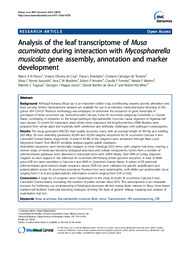Analysis of the leaf transcriptome of Musa acuminata during interaction with Mycosphaerella musicola: gene assembly, annotation and marker development.
Analysis of the leaf transcriptome of Musa acuminata during interaction with Mycosphaerella musicola: gene assembly, annotation and marker development.
Author(s): PASSOS, M. A. N.; CRUZ, V. O. de; EMEDIATO, F. L.; TEIXEIRA, C. C. de; AZEVEDO, V. C. R.; BRASILEIRO, A. C. M.; AMORIM, E. P.; FERREIRA, C. F.; MARTINS, N. F.; TOGAWA, R. C.; PAPPAS JÚNIOR, G. J.; SILVA JUNIOR, O. B. da; MILLER, R. T N. G.
Summary: Background: Although banana (Musa sp.) is an important edible crop, contributing towards poverty alleviation and food security, limited transcriptome datasets are available for use in accelerated molecular-based breeding in this genus. 454 GS-FLX Titanium technology was employed to determine the sequence of gene transcripts in genotypes of Musa acuminata ssp. burmannicoides Calcutta 4 and M. acuminata subgroup Cavendish cv. Grande Naine, contrasting in resistance to the fungal pathogen Mycosphaerella musicola, causal organism of Sigatoka leaf spot disease. To enrich for transcripts under biotic stress responses, full length-enriched cDNA libraries were prepared from whole plant leaf materials, both uninfected and artificially challenged with pathogen conidiospores. Results: The study generated 846,762 high quality sequence reads, with an average length of 334 bp and totaling 283 Mbp. De novo assembly generated 36,384 and 35,269 unigene sequences for M. acuminata Calcutta 4 and Cavendish Grande Naine, respectively. A total of 64.4% of the unigenes were annotated through Basic Local Alignment Search Tool (BLAST) similarity analyses against public databases. Assembled sequences were functionally mapped to Gene Ontology (GO) terms, with unigene functions covering a diverse range of molecular functions, biological processes and cellular components. Genes from a number of defense-related pathways were observed in transcripts from each cDNA library. Over 99% of contig unigenes mapped to exon regions in the reference M. acuminata DH Pahang whole genome sequence. A total of 4068 genic-SSR loci were identified in Calcutta 4 and 4095 in Cavendish Grande Naine. A subset of 95 potential defense-related gene-derived simple sequence repeat (SSR) loci were validated for specific amplification and polymorphism across M. acuminata accessions. Fourteen loci were polymorphic, with alleles per polymorphic locus ranging from 3 to 8 and polymorphism information content ranging from 0.34 to 0.82. Conclusions: A large set of unigenes were characterized in this study for both M. acuminata Calcutta 4 and Cavendish Grande Naine, increasing the number of public domain Musa ESTs. This transcriptome is an invaluable resource for furthering our understanding of biological processes elicited during biotic stresses in Musa. Gene-based markers will facilitate molecular breeding strategies, forming the basis of genetic linkage mapping and analysis of quantitative trait loci.
Publication year: 2013
Types of publication: Journal article
Observation
Some of Embrapa's publications are published as ePub files. To read them, use or download one of the following free software options to your computer or mobile device. Android: Google Play Books; IOS: iBooks; Windows and Linux: Calibre.
Access other publications
Access the Agricultural Research Database (BDPA) to consult Embrapa's full library collection and records.
Visit Embrapa Bookstore to purchase books and other publications sold by Embrapa.

